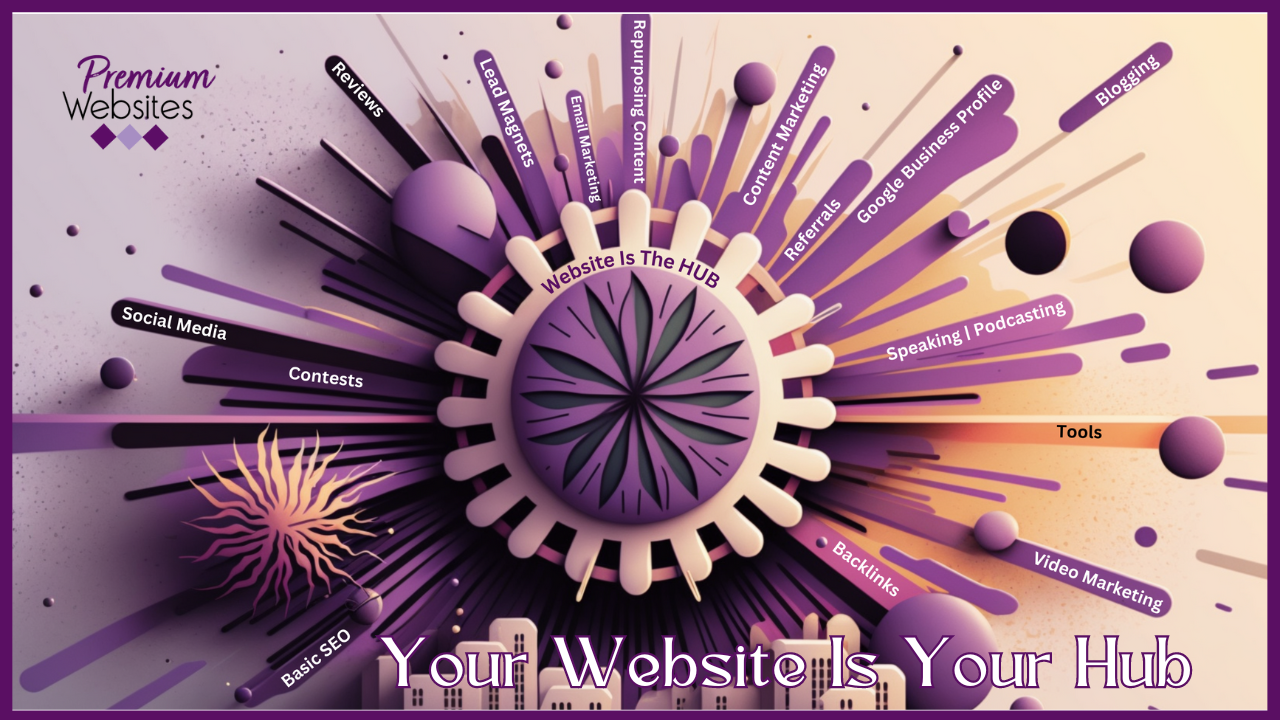
Your Website Is Your Online Hub
Have you ever considered your website the bustling city center of digital marketing? Picture this: a lively hub where all roads – social media posts, email newsletters, blog articles – lead back to. It’s here that customers meet and engage with your brand.
Your website is your hub, a powerful beacon guiding potential clients through the vast online wilderness into your business’s welcoming embrace. Every tweet or post is like a trail marker leading people back home – to your site.
And why does this matter?
Get ready to see how nailing down this idea can boost visits to your homepage (think of it as your main street), ramp up conversions, and forge enduring connections. Curious? Stick around because we’re just getting started.
Table of Contents
- Your Website as the Central Hub of Your Online Presence
- Driving Traffic to Your Website through Various Channels
- Creating Engaging Content on Your Website
- Building Trust and Relationships through Your Website
- Leveraging Email Marketing to Boost Website Traffic
- Optimizing Your Website for Search Engines
- Measuring Your Website’s Performance
- Establishing Your Website as a Content Hub
- Conclusion
Your Website as the Central Hub of Your Online Presence
Imagine your online presence like a solar system. In this vast digital universe, your website is the sun – it’s at the center, holding everything else in its orbit. Think of social media platforms, email newsletters, and even YouTube channels as planets revolving around it.
Facebook, YouTube, and Instagram – all offer opportunities to engage with potential customers and drive traffic back to your central hub: your business website. This is where brand awareness blossoms into building relationships with a loyal customer base.
The Role of a Website in Digital Marketing
A well-crafted website does more than exist; it actively contributes to an effective digital marketing strategy by showcasing great content related to specific topics or products relevant to search engines and potential clients.
Websites also hold some significant advantages over other media platforms. Unlimited content potential makes websites a highly flexible and advantageous choice compared to other platforms. They provide greater flexibility than rigid structures on popular platforms like Instagram or YouTube. Plus, when strategically optimized for organic search (more commonly known as Search Engine Optimization), websites become beacons drawing attention from far-flung corners of cyberspace onto their landing pages.
- Your website offers boundless space for blog posts and videos centered around long-tail keywords relevant to what people are looking up.
- Email newsletters can effectively share content while linking to various sections within your site, building trust among subscribers who recognize consistent quality.
- Control over the main navigation means users can quickly find what they need.
Studies suggest that well-made sites with valuable content have a greater chance of appearing higher in Google search results. Now, that’s worth paying attention to.
Driving Traffic to Your Website through Various Channels
The online world is a bustling marketplace, and your website stands as the central hub of all your digital marketing efforts. But how do you get potential customers to visit? Inviting people to your digital hub is like throwing a bash – if you want folks to show up, you must send out the invites.
Utilizing Social Media Platforms for Traffic Generation
Social media platforms are akin to loudspeakers that amplify your message across many people. When used effectively, Facebook posts can be potent traffic generators; they act like little billboards driving traffic toward your business’s central hub – its website. Adding links in video descriptions or at the end of videos on YouTube can create an easy pathway for curious viewers back to your site.
Link Building Strategies for Traffic Generation
Beyond social networking sites lies another powerful method: link-building within content promotion. This strategy isn’t just about having others spread the word about our fabulous party (website); it’s also about making sure those directions lead straight home. Strategic link building helps improve organic search results on search engines like Google, boosting visibility and bringing more visitors to your landing page.
A well-planned mix of these methods ensures that no matter where someone finds you—from browsing social networks or following a shared link—they’re led right back to your website: the center stage where you shine brightest.
Creating Engaging Content on Your Website
Your website is a limitless platform for content. It’s like your playground, ready to be filled with blog posts, infographics, videos – you name it. But how do you ensure these pieces are not just taking up space but engaging your audience?
The secret sauce lies in two main ingredients: relevancy and diversity.
Relevancy Through Keywords
Think of relevant keywords as the language of your target audience. They’re phrases or words people use when they’re searching for something specific online. In this context, we’re talking about pay-per-click ads. These landing pages should speak directly to what someone wants when they click on an ad. Effective landing pages can drastically improve conversion rates and ensure that every dollar spent returns to you.
Diversity With Different Types Of Content
Variety keeps things interesting. Providing a range of content options, such as long-form blog posts and educational infographics, can help to keep users engaged with your brand.
- In-depth Blog Posts: These aren’t just any blogs; think 1000+ word articles packed full of valuable information related specifically to the needs or interests of your customer base.
- Educational Content: This type educates readers about topics related to their interests or potential problems they may face. The aim here isn’t direct selling but establishing yourself as an expert who provides valuable advice – building trust along the way.
- Visual Content/Infographics: This type breaks down complex data into digestible visuals that keep people engaged and make your content shareable.
When creating these pieces, remember to keep them centered around a specific topic or central theme. This helps ensure that the right audience finds you and gets exactly what they need from your website – great content.
Building Trust and Relationships through Your Website
Your website is a crucial tool for establishing trust with your audience. Visitors coming to your website should feel a sense of assurance and make them welcome right away, showing that you are legitimate.
The Power of First Impressions
You know what they say – first impressions last. So, make sure yours counts by designing an aesthetically pleasing and easy-to-navigate user interface. A poorly designed website can drive away incoming traffic as quickly as it arrives.
A well-crafted landing page helps guide potential customers toward their desired destination without confusion or delay. Creating a welcoming environment is vital to fostering trust and forming relationships.
Cultivating Trust Through Consistency
Consistent messaging across all pages also contributes significantly to building relationships. This consistency extends to visuals, tone of voice, content quality, branding elements, and customer service responses.
To build brand awareness effectively through consistency, consider this analogy: imagine every Starbucks cafe had a different logo or served coffee in red cups instead of green. The inconsistency would be confusing at best.
Fostering Connections via Engaging Content
Serving up engaging content regularly will keep users coming back for more. Offering valuable insights shows you’re invested in providing something meaningful rather than simply selling a product or service.
Publishing case studies is a way businesses show authenticity while demonstrating success stories with real clients — similar to having friends vouch for us when meeting new people. Now, isn’t that better than relying solely on faceless testimonials?
Keeping the Conversation Going
Maintaining a connection with your crowd encourages a feeling of solidarity. Features such as live chat or forums give visitors a direct line to you, which is critical in establishing trust and building relationships.
Remember, people don’t like talking to walls. They want interaction and engagement and to feel heard.
Key Takeaway:
First impressions on your website matter. An inviting design, consistent messaging across all pages, and engaging content help build trust with visitors. Regularly providing valuable insights shows commitment beyond just selling a product or service. Maintaining open communication lines fosters community and makes users feel heard.
Leveraging Email Marketing to Boost Website Traffic
Email marketing is like a golden ticket. Email marketing can be an extremely effective way to generate website visits and boost conversion rates.
How so? Let me tell you my story. I started using an email newsletter strategy for my business a few years ago. What I noticed was remarkable – the newsletters were helping me maintain communication with my customer base and driving them back to my site.
The secret sauce here is valuable content that appeals directly to your audience’s interests and needs. But remember, every good recipe has more than one ingredient.
An Engaging Subject Line: The Bait on Your Hook
A catchy subject line is akin to great bait on a fishing hook – it catches attention instantly. Ensure each subject line resonates with your target audience to get people interested in opening your emails (and clicking through).
Purposeful Content: Reeling Them In
Now we have their attention, let’s reel them in. How, you ask? By crafting purposeful content within these emails. HubSpot suggests informative articles or how-to guides work best because they offer value beyond sales pitches. Make it about ‘them’.
Incorporating Strategic Links: Landing the Catch
This part of our little fishing expedition involves strategic link placement within your newsletters—a technique as delicate as landing a feisty fish after a long fight.
You see, strategically placed links act as bridges connecting readers from the inbox straight into different sections of your website—an area offering further information or, even better, a landing page primed for conversions.
So, let’s bring some stats into the mix. According to Campaign Monitor, every dollar spent on email marketing generates $38 in ROI. That’s not just because of direct sales from emails but also due to increased web traffic and subsequent conversions.
The Golden Rule: Keep it Simple, Silly (KISS)
Just remember this – make sure your newsletters are clear and readable, and pack a punch with visible links leading back to your website. These should be appealing enough to draw readers in.
Key Takeaway:
Email marketing is a golden ticket to boost your website traffic. You’ll catch your audience’s attention by crafting engaging subject lines and valuable content. Strategically placed links within the email can direct them to various sections of your site or conversion-ready landing pages. Always remember – keep it simple yet impactful.
Optimizing Your Website for Search Engines
The magic of making your website more visible on search engines lies in the art and science known as search engine optimization (SEO). Picture SEO like a spotlight, shining brightly on your site amidst the vast digital universe.
A key stat is that websites generally have better search engine optimization than other platforms. This is because they offer total control over elements that influence rankings, from content quality to site structure.
Finding Relevant Keywords
To start optimizing, you need relevant keywords. Think of these as secret keys that unlock higher positions in search results. You don’t just want any keys; you need those crafted with precision—long-tail keywords tailored explicitly towards what potential customers are looking for.
Crafting Quality Content Around Keywords
What is your next step? Weave these carefully chosen words into high-quality blog posts or case studies. Remember, though, Google’s intelligent algorithms can smell keyword stuffing a mile off. So be savvy and keep it natural within your content pieces.
Incorporating Internal Linking Strategies
A good internal linking strategy can also help boost visibility. By creating links between different pages on your website, you’re essentially giving users—and search engines—a roadmap of related topics they might find interesting.
Taking Advantage of Metadata
Last but not least comes metadata – think book blurb for each page on your site, which tells users and google what this specific subject is about before clicking through.
Remember, robots don’t just love a well-optimized website—it’s user-friendly too. It means clear menus (main navigation, anyone?), fast loading times, and a responsive design. All these make for a great user experience that search engines reward with better visibility.
SEO is an ongoing process—kind of like keeping fit. You can’t just do one workout and expect to stay in shape forever. Regular tweaks based on performance metrics are key to maintaining your SEO fitness level.
Measuring Your Website’s Performance
Keeping tabs on your website’s performance is like being a savvy ship captain. You need to regularly check your compass (analytics) and map (strategy), ensuring you’re on course for success.
Your 24/7 Sales Rep
What is the beauty of having a business website? It never clocks out. Accessible from anywhere worldwide, it tirelessly promotes your brand and attracts potential customers. Just imagine this – while enjoying a cup of coffee or catching some Zs, someone could browse your site halfway across the globe.
A Full Funnel Experience
An effective website provides information that caters to every buying cycle stage. Think about it as guiding visitors down an inviting path – from curious browsers to satisfied customers.
The Need for Tracking Key Metrics
To ensure optimal performance, we must ensure our ‘ship’ stays seaworthy. That means tracking key metrics such as conversion rates and lead generation numbers. These figures give us invaluable insights into how well our online marketing efforts pay off.
- Conversion rate: This measures what percentage of visitors take desired actions – filling out forms, signing up for newsletters, making purchases, etc.
- Lead Generation: How many new potential clients have our content attracted?
This process isn’t just about collecting raw data; analysis is equally crucial. We must delve deeper into these numbers and understand what they tell us about visitor behavior patterns.
Establishing Your Website as a Content Hub
Your website should be more than just an online business card; it can be a bustling content hub, drawing in visitors like bees to honey. And the sweet nectar they’re after? Great content.
The beauty of your site is its flexibility compared to other platforms such as YouTube, Instagram, and email newsletters. Here, you control every aspect – from design to the content you share.
Mix It Up: The Key Ingredients for a Rich Content Soup
In creating this digital soup, a variety spices things up. Blog posts offer deep dives into specific topics, while infographics visualize complex ideas. Videos provide engaging experiences that keep people on your page longer (which search engines love.). Each piece adds flavor and attracts different taste buds – or potential customers.
Become Google’s Best Friend with SEO Optimization
You’ve got all this great stuff simmering on your website now, but how do we make sure people find it? That’s where Search Engine Optimization (SEO) steps in.
By using relevant keywords within your quality content, Google will see you’re knowledgeable about these subjects and provide value for users searching these terms. As a result, it’ll rank your pages higher, making them easier to discover through organic searches.
Freshly Baked Content Keeps Visitors Coming Back For More
Last but certainly not least is freshness. As any good baker knows, if you want repeat customers, something new must always come out of the oven. In web terms – regularly updated and fresh content keeps visitors returning repeatedly.
To sum up, having diverse types of valuable and fresh content on your website turns it into a bustling hub that draws in visitors like flies to honey. Now, who wouldn’t want that?
Conclusion
We’ve journeyed through everything from your online presence’s bustling city center to its quaint backstreets. Your website is your hub, and now you know why.
Embrace social media platforms for traffic generation and remember strategic link-building strategies. They’re like signposts guiding visitors right onto your digital main street.
Create engaging content on your site – think blog posts or infographics – with relevant keywords in mind. Remember: good content isn’t just about selling; it’s also about building relationships and trust.
Leverage email marketing effectively to drive more footfall (or click-fall) to your site. And let’s not forget SEO! Optimizing for search engines will help boost visibility and attract organic traffic – a boon if there ever was one!
Your efforts shouldn’t stop at creation—measuring performance is crucial too! Track key metrics like conversion rate so you can tweak things as needed because a well-oiled machine needs regular check-ups!
Above all else, remember this: an effective business website is more than just a static billboard—it’s an active content hub where customers meet, engage, learn…and buy from YOU.



